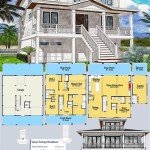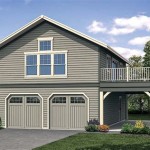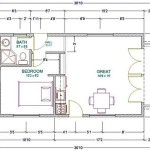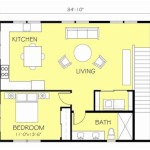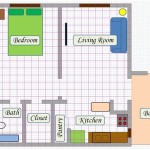How To Create Floor Plans For Free
Creating floor plans used to require specialized architectural software and considerable technical skill. However, the advent of user-friendly online tools has democratized the process, allowing individuals to generate floor plans for free. This capability is valuable for various purposes, including home improvement projects, real estate marketing, space planning, and interior design experimentation. Several free platforms offer the necessary tools and features to create detailed and accurate floor plans without incurring any costs.
This article provides a comprehensive guide on how to create floor plans for free, detailing the available resources, step-by-step instructions, and essential considerations for producing professional-looking results. The focus is on utilizing readily accessible online tools and techniques to empower users, regardless of their technical expertise, to design and visualize their spaces effectively.
Choosing the Right Free Floor Plan Software
The first step in creating floor plans for free is selecting the appropriate software. Several online platforms offer free versions of their floor plan creation tools. These free versions typically have limitations compared to their paid counterparts, such as restricted features, limited project storage, or the presence of watermarks. Nevertheless, they are often sufficient for basic floor plan design needs.
Consider the following free floor plan software options:
- Floorplaner: Floorplaner offers a comprehensive suite of tools for creating 2D and 3D floor plans. The free version allows users to create and save a limited number of projects and provides access to a basic library of furniture and fixtures. It's a user-friendly option suitable for both beginners and experienced designers.
- Planner 5D: Planner 5D is known for its intuitive interface and extensive catalog of design elements. The free version offers access to many of its features, allowing users to create detailed floor plans and experiment with different layouts and styles. However, some advanced features and items are locked behind a paywall.
- RoomSketcher Free: RoomSketcher offers a free version that allows users to create floor plans and generate 2D and 3D visualizations. The free version includes limitations on the number of projects and features available. However, it provides a good starting point for creating basic floor plans and exploring design ideas.
- SketchUp Free: While primarily a 3D modeling software, SketchUp Free can also be used to create floor plans. It offers a more advanced set of tools and requires a steeper learning curve compared to other options. However, it provides greater flexibility and customization options for experienced users.
When choosing software, consider the following factors:
- Ease of Use: The interface should be intuitive and easy to navigate, especially for users with limited experience in design software.
- Features: Ensure that the free version offers the necessary features for creating the desired floor plan, such as drawing tools, measurement tools, and a library of furniture and fixtures.
- Compatibility: Verify that the software is compatible with the user's operating system and web browser.
- Output Options: Check the available export formats and resolution options for saving and sharing the floor plan.
Step-by-Step Guide to Creating a Floor Plan
Once the user has selected the appropriate software, the following steps outline the process of creating a floor plan:
- Measure the Space: Accurate measurements are crucial for creating a realistic and functional floor plan. Use a laser measuring tool or a measuring tape to record the dimensions of each room, including the length, width, and height. Note the location of doors, windows, and any fixed elements such as fireplaces or built-in cabinets.
- Create a Basic Outline: Start by creating a basic outline of the floor plan using the software's drawing tools. Input the room dimensions accurately, ensuring that the walls are aligned correctly. Pay close attention to the scale to maintain the proportions of the space.
- Add Walls and Partitions: Use the software's wall tool to add interior walls and partitions to define the individual rooms. Ensure that the wall thickness is accurate and consistent throughout the floor plan.
- Insert Doors and Windows: Add doors and windows to the floor plan, placing them in their correct locations. Select the appropriate door and window styles and sizes from the software's library. Ensure that the doors swing in the correct direction and that the windows are positioned at the correct height.
- Add Furniture and Fixtures: Populate the floor plan with furniture and fixtures to visualize the layout and functionality of the space. Select items from the software's library or create custom elements using the drawing tools. Arrange the furniture and fixtures to create a comfortable and functional living environment.
- Add Dimensions and Labels: Add dimensions and labels to the floor plan to provide accurate information about the size and layout of the space. Use the software's dimension tools to measure the length and width of each room and label the doors, windows, and other features.
- Review and Refine: Once the floor plan is complete, review it carefully to ensure that all measurements are accurate and that the layout is functional. Make any necessary adjustments and refinements to improve the design.
- Save and Export: Save the floor plan in the appropriate file format and export it for sharing or printing. Choose a high-resolution format to ensure that the plan is clear and legible.
Essential Considerations for Accuracy and Functionality
Creating an accurate and functional floor plan requires attention to detail and a thorough understanding of design principles. Consider the following essential points:
Accuracy of Measurements: As previously stated, accurate measurements are essential for creating a realistic and functional floor plan. Double-check all measurements and ensure that they are consistent throughout the plan. Small errors in measurement can significantly impact the overall layout and functionality of the space.
Scale and Proportion: Maintaining the correct scale and proportion is crucial for creating a visually appealing and functional floor plan. Ensure that all elements are drawn to scale and that the proportions of the rooms and furniture are accurate. Use the software's scaling tools to adjust the size of elements as needed.
Traffic Flow and Circulation: Consider the traffic flow and circulation patterns within the space when designing the floor plan. Ensure that there is adequate space for movement and that the layout promotes a comfortable and efficient flow of traffic. Avoid creating narrow corridors or placing furniture in areas that obstruct movement.
Functionality and Ergonomics: Design the floor plan to meet the specific needs and requirements of the occupants. Consider the intended use of each room and arrange the furniture and fixtures to create a functional and ergonomic living environment. Ensure that there is adequate storage space and that the layout is conducive to the intended activities.
Accessibility and Universal Design: Incorporate accessibility features and universal design principles to create a floor plan that is usable by people of all abilities. Consider the needs of individuals with disabilities, such as wheelchair users or individuals with limited mobility. Ensure that there are adequate clearances for wheelchairs and that the layout is free of obstacles that could impede movement.
Lighting and Ventilation: Consider the natural lighting and ventilation within the space when designing the floor plan. Position windows to maximize natural light and ventilation and ensure that there is adequate artificial lighting to supplement the natural light. Consider the placement of HVAC systems to ensure proper ventilation and temperature control.
Furniture Placement and Arrangement: The arrangement of furniture significantly impacts the functionality and aesthetics of a space. Strategic furniture placement helps to optimize traffic flow, create focal points, and define zones within a room. Experiment with different layouts to determine the most effective arrangement for the user's needs and lifestyle.
Doors and Windows Considerations: The placement and type of doors and windows are critical considerations for a functional floor plan. Ensure doors swing in logical directions and don't obstruct traffic flow. The size, style, and placement of windows should maximize natural light while providing appropriate privacy and ventilation. Ensure the accurate representation of window and door dimensions within the plan.
Using Templates as a Starting Point: Many free floor plan software options offer templates that can serve as a starting point for design. Templates can provide a pre-designed layout that can be customized to fit individual needs. Review and adapt templates carefully, however, to ensure they accurately reflect the user’s specific measurements and requirements.
Understanding Building Codes and Regulations: While many are using these tools for personal projects, it is essential to understand that real-world construction must adhere to local building codes and regulations. While free floor plan software can help visualize designs, it is not a substitute for professional architectural services when creating plans for construction or renovation. Before undertaking any construction project, always consult with qualified professionals to ensure compliance with all applicable codes and regulations.

Floor Plan Creator Planner 5d

Floor Plan Creator And Designer Free Easy App

20 Best Floor Plan Apps To Create Your Plans Foyr

Floor Plan Creator Planner 5d

11 Best Free Floor Plan For 2024

Floor Plan Creator And Designer Free Easy App

Draw Floor Plans With The Roomsketcher App

Floor Plan Maker

Draw Floor Plans With The Roomsketcher App

Floor Plan Creator Planner 5d

